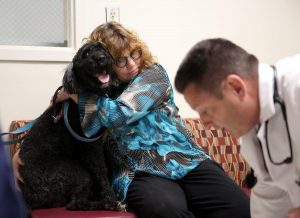

By Luanne Rife luanne.rife@roanoke.com
Emily’s first seizure scared her companion, Laura Kamienski, but their veterinarian near their Pittsburgh home suggested that the Portuguese water dog might have gotten into something she shouldn’t.
But a second seizure soon followed, arriving the day before Emily was set to have knee surgery. The vet canceled the surgery and suggested an MRI of the dog’s brain. The image revealed a brain tumor, and the vet suspected a glioma, a class of tumors that form from glia cells, which, along with neurons, are one of two types of brain cells.
Unlike more treatable cancers that form in another part of the body and migrate to the brain, gliomas, and particularly glioblastomas, are always fatal. It’s the type of cancer that killed Ted Kennedy and Bo Biden and that was diagnosed recently in John McCain.
Dogs and their human companions get the same types of tumors. Treatment options for both are limited.
“The only treatment at Pittsburgh was radiation therapy that would have cost $10,000, which I didn’t have. I would have found it if I had to, but it would have bought her maybe three months,” Kamienski said.
Without treatment, Emily had about two months to live.
But there was one other option, and one that Kamienski seized.
The Virginia-Maryland College of Veterinary Medicine is doing what is called a comparative oncology trial on dogs to determine if a cancer-cell-destroying drug delivered directly to a glioma can kill the tumor without harming the rest of the brain and give the dog a longer, symptom-free life.
Kamienski brought Emily to Blacksburg in April for the treatment. They returned June 22 to see if it was working.
While Emily was being prepared for another MRI, Kamienski waited on a bench outside.
“I’m hopefully optimistic. If it comes back and it’s grown, I’m going to be shocked and devastated,” she said. “I know it’s not a cure.
My eyes are open. There is not a cure. So the success would be to give her a year, two years, and that’s what I’m hoping for.”
Targeted treatment
Emily is the 15th dog that veterinarian neurosurgeon Dr. John Rossmeisl has enrolled in this clinical trial.
The drug targets a specific abnormal protein that is found only on brain cancer cells.
“The payload — which is actually a genetically engineered, very potent toxin made from bacteria — gets into the cancer cell and kills the cancer cell,” he said.
It does not appear to harm normal brain cells.
The drug was developed by Dr. Waldemar Debinski, director of Wake Forest’s Brain Tumor Center of Excellence. Rossmeisl said he met Debinski at a scientific seminar about 20 years ago when he first joined the vet school’s faculty, and they’ve been working together on brain cancers since then.
The cancer-killing toxin went through human clinical trials about a decade ago, but the study had a few flaws.
“Part of the difficulty is with the blood-brain barrier. The vast majority of drugs, if you take them by mouth or you inject them, they will never reach concentrations that are adequate to treat cancer in the brain,” he said. “The only way to get them to the brain is actually to deliver them locally to the tumor.”
During the human trials, surgeons drilled a small hole through the patients’ skulls, placed tiny catheters into the tumor, woke the patients and then began the slow drip of the drug through the catheters into the brains.
“What they didn’t do was watch to make sure the drug was going where they wanted it to and covering the tumor,” Rossmeisl said.
And what they didn’t have then were catheters designed specifically for the brain. Nor did they test the tumors first to see if they had the specific protein.
Despite the shortcomings, some patients did well, living months longer than expected, he said.
For the current trial, Rossmeisl first confirms through a biopsy that the tumor has the specific protein markers. With Emily, he wasn’t sure at first that she had a glioma, as that type of tumor isn’t common to her breed. Mostly they occur in short-nosed breeds such as boxers, bulldogs and Boston terriers.
Then, using a drug and catheters that have been refined during the last decade, he watches through an MRI to make sure the drug is covering the tumor.
The trial is designed to determine a safe dosage that the FDA will allow to advance to human trials.
Rossmeisl began in 2014 with the first three dogs and gave them a low dose. When they did not experience side effects, he doubled the dose for the next three dogs, and so on. Emily, the 15th dog in the trial, received a dose that’s been doubled four times.
Kamienski reports, “She’s back to being herself,” a phrase Rossmeisl said he has heard repeatedly.
“That’s the potential benefit of this. Since the drug only attacks cancer cells, even if it comes in contact with normal brain cells, it doesn’t do anything to them,” he said. “Therefore, it should be very, very safe.”
Though the first dogs did not become ill from the treatment, their tumors did not respond.
But as the dosage increased, “We’ve seen a response in every subsequent group of 50 percent or more shrinkage,” he said. “We’ve seen some not quite disappear, but have 97 percent shrinkage.”
All of the dogs’ tumors eventually come back, as these types of tumors are notorious for their aggressiveness.
But, Rossmeisl said, the dogs enrolled in the study have had no other treatment.
“So if you actually treated this like you would aggressively in a person, by removing it surgically, then irradiating it and then giving the drug, theoretically you could affect a more significant response,” he said.
From dogs to humans
The National Institutes of Health’s National Cancer Institute recently awarded a $9.2 million grant to a team of veterinarians (including Rossmeisl), engineers, cancer researchers and surgeons from Virginia Tech and Wake Forest University to test in humans some of the treatments they’ve developed for glioblastoma.
Rossmeisl expects that by the time the new Virginia Tech Carilion Research Institute building opens in Roanoke in 2020, the trial will be ready to move from dogs to their best friends. The vet school is moving and expanding its Comparative Oncology Research Center to the Roanoke building.
In comparative oncology, researchers and doctors who study humans and dogs work together to develop new approaches for cancer. Since similar cancers arise in both, dogs can be used in the trials first to determine if a treatment will work safely.
“This is not experimental. I am not giving dogs brain cancer and treating it. These dogs have a deadly illness that is naturally occurring,” Rossmeisl said. “These are tumors that spontaneously arise, and without treatment these dogs are going to die. And unfortunately, even with treatment, these dogs are going to die.”
But the dogs are living longer. The average dog with a glioma will live two months. Some of the dogs in the study have lived nine months and with a better quality of life.
Buying time
Rossmeisl enters the exam room and is greeted by an energetic, tail-wagging Emily and her hopeful companion.
Kamienski reports that Emily is doing well. No seizures. She’s put on some weight, and her knee isn’t bothering her as much as it had. As if to punctuate this observation, Emily jumps onto the exam room furniture.


After a quick check, Emily is ready to go off with the anesthesia team and prepare for the MRI.
Both her doctor and companion expect good news.
“Considering how well she’s doing, I’m optimistic that things are going to look OK in there,” Rossmeisl said. “Sometimes when you are treating cancer, even if the tumor isn’t smaller, if it’s not bigger that isn’t necessarily a bad thing. If we’re keeping it in check, it is not as good a victory as having it go away. But as long as we’re stopping it, sometimes it’s small victories.”
But as she waits, Kamienski is expecting a big victory. Emily has been her companion for 10 years. She credits Emily with saving her life when they were living in New York.
“I got involved with somebody who turned out to be a sociopath. He literally destroyed my life. During that time, I got Emily. When it started to affect her, and hurt her, that’s when I said enough is enough,” she said.
Kamienski and Emily moved to Arizona.
“It took me months, a year, to recover. I was financially and emotionally destroyed. She was my shoulder to cry on, she was the only being that brought me joy,” Kamienski said. “She was my company. She was my family. She was my everything, and still is.”
A few hours later, Rossmeisl was able to tell her that Emily’s MRI shows promise. The tumor is smaller and parts of it are dying.
Kamienski, Emily and Emily’s 4-year-old brother Leo have more time now.
“The great part of my job satisfaction is I get to help my patients, dogs, with a really bad disease,” Rossmeisl said. “And hopefully someday I can help someone’s mother or father or sister or brother or child.”
About the author: Luanne Rife
Luanne Rife writes about the businesses, policies, discoveries and inventions that affect the health of people living in southwestern Virginia.








